2017 ohio state
I'd probably ask for this at my wedding, too. It just makes sense.
Get out there and be the best 38 yr old dad guy you can be! @AceAnbender @mgoblog pic.twitter.com/oK2nvIq9n5
— Stephen Szuch (@stephenszuch) May 11, 2018
FIRED UP NOW LET'S HAVE A 45 MINUTE SPEECH FROM THE FATHER OF THE BRIDE
You might have to watch the Nets? Jonathan Givony's post-lottery mock draft includes one Moe Wagner at #29:
The Nets don't have much in the way of shooting in the frontcourt and aren't really committed to any 4s or 5s long term besides promising rookie Jarrett Allen and the dead-weight contract of Timofey Mozgov.
Wagner brings floor spacing and a high-energy style of play. He was one of the breakout players of March, leading Michigan to a Big Ten title and a surprise run to the NCAA championship game.
The Raptors have traded that pick to the Nets, so that would mean Caris Levert, Nik Stauskas, and Wagner were all… uh… Nets. Since mock drafts are deadly accurate, NY-based Michigan grads should buy their season tickets now.
This is not a layup-focused point guard. IA PG DJ Carton's latest highlight video is mostly nasty contested dunks.
“We ain’t got ties, you ain’t gon ride” s/o @MovementHoops pic.twitter.com/E2tMFis87q
— Dee Jay (@DJCarton) May 14, 2018
Michigan hasn't had a PG who dunked regularly since… Darius Morris? Except he couldn't really get to the rim?
Who needs long twos? Bart Torvik tracks a remarkable drop in non-rim twos over just a few years:
Median team's % shots that were "other twos":
— Bart Trvik (@totally_t_bomb) May 16, 2018
2013: 32.5%
2014: 31.4%
2015: 31.0%
2016: 29.0%
2017: 28.6%
2018: 26.3%
I preferred our previous ignorance about Crisler's scorer, because back in those innocent days I could point out that Michigan's defensive renassaince was in no small part because they were elite at forcing non-rim twos. Now I can only suspect that. Now I know that some part of that is a home scorer who thinks only uncontested dunks or layups are "at the rim."
Well, yeah. A slice of life from All Or Nothing:
One of the more telling sequences from Amazon’s behind-the-scenes look at Michigan’s 2017 season came during the Wolverines’ 42–13 loss at Penn State. After another failed drive, Michigan quarterback John O’Korn came to the sideline. “No blocking,” O’Korn told Harbaugh. “There’s no blocking.”
Andy Staples inserts that into a piece about Shea Patterson's attempt to save Michigan's offense. I do have an issue with Staples citing raw yards per carry numbers from Michigan's less successful outings on the ground:
Last season, they averaged 2.6 yards a carry against Michigan State, 2.5 yards a carry against Penn State, 1.5 yards a carry against Wisconsin, 2.8 yards a carry against Ohio State and 2.2 yards a carry against South Carolina. That places even more pressure on the quarterback, figuratively (because he’s expected to do it all) and literally (because blocking poorly leads to large humans in the quarterback’s face and the lack of a run game means defenses can dedicate more bodies to covering potential targets).
Once you move sacks to the correct bin, Michigan averaged 3.9, 4.3, 2.2, 4.6, and 2.9 YPC in those games, which is not good but is a considerably more accurate evaluation than sack-included numbers for the #117 pass pro team in the country.
And Staples gets the causation backwards in his final hypothetical. To pick one example from many, here's this site's take after Penn State:
Another thing to note on this one is the safety who eventually tackled Evans: he is rotated back by the motion and spends a second or two reading the play out before barreling downfield. That makes for a good gain instead of good blocks and three yards. The difference between that nine yard gain and this three yard one is evident:
PSU safety to top of screen
PSU also got a DT out there on a stunt, but that's just a thing that happened. It's not a trend. The trend is the safeties firing at Michigan's ground game with impunity. PSU's safety froze on the first one because he didn't know what he was looking at. Once he saw the play once he was able to fire because nobody cares about Michigan's passing game. That's a version of what happened to early Rodriguez offenses where the new stuff would work for a bit and then when the defense had seen it they curled up and died, because they could only do one thing.
Michigan's lack of a passing game stifled their run game, not vice versa. Patterson's worst case scenario is a thousand times better than what Michigan got from the spot a year ago. It'll all go to hell if Michigan can't pass protect better, but Patterson really does solve a swath of Michigan's issues just by being a proven P5 quarteback.
Speaking of. If you can stomach it, James Light highlighted a couple of Michigan's many, many missed opportnities against Ohio State:
— James Light (@JamesALight) May 12, 2018
Z Topper X Shallow pic.twitter.com/kMgFbR2GK1
— James Light (@JamesALight) May 12, 2018
Patterson certainly would have won that game, for one.
Can anyone catch up? A Jalen Wilson post-visit interview($) is mostly unrevealing, but he does omit UCLA as a contender and say he's going to commit before his school year starts. Wilson's visit generated a big Michigan run on the crystal ball, with both Steve Lorenz and Josh Henschke joining various others.
Wilson has as-of-yet unscheduled visits he wants to take to Baylor, Marquette, Oklahoma State, and Kansas. Hopefully those remain vague.
Pitino flips! In the media! The Washington Post has an extensive story on new IU recruit Romeo Langford's college decision featuring one Rick Pitino:
In January 2017, Pitino said, two Adidas officials met with him to discuss their efforts to keep Nike and Under Armour from landing Langford, whom Pitino was recruiting. Pitino’s account was supported by text messages he shared with The Washington Post for a previous story.
“The way they phrased it, it was [whichever shoe company] was going to pay the dad’s AAU program the most money, gets it,” Pitino said in a recent phone interview. A few days later, Adidas’s league added a new team: Twenty Two Vision, featuring Romeo Langford on the court and Tim Langford as team director. Shoe company sponsorships can reach $100,000 to $150,000, and team directors who limit expenses can pay themselves salaries from those amounts.
“That’s the way that world works,” Pitino said. “Which is completely legal, by the way.”
This space is in full heighten the contradictions mode about college basketball and welcomes any and all revelations about how ineffectual the NCAA's attempts to prevent money from flowing to folks with marketable skills are. A pissed-off Rick Pitino napalming everyone he can in the Washington Post is a boon for everyone.
Etc.: A Villanova rematch looms.
[Patrick Barron]
For many reasons I loved Harbaugh’s offensive game plan against Ohio State. He knew Ohio State well, knew his players better, and nearly made up an entire massive talent gap between the two teams with coaching alone. One minute they’d be in super-wide splits and running up the gut, the next play they’d be in super-packed goal line, fake a handoff to Hammerin Panda, and slip a TE for an easy touchdown. Next drive they come out in a split-backs right out of a Bill Walsh playbook, plus a bunch of spread.
Ohio State ran a pretty basic defense; at this point they’re just churning through five-stars Calipari-style, and giving them a basic Quarters/Cover 1 system with one or two checks based on alignment. But Michigan’s offense wasn’t anywhere near that level last year. So Harbaugh pulled plays from every offensive tree, whipsawing the OSU defense between dramatically different concepts until he found a few that the Buckeye checks made wrong. Was it complicated? Well yeah, they practiced this stuff all season and emptied the drawer for the Game. Did it work? Brilliantly.
--------------------------------
THE SETUP
One of those successful attacks was a packaged play they broke out to save a 1st and 17 in the shadow of their own endzone early in the 2nd quarter, then twice more during an important drive down 24-20 in the 4th. But before they broke out the big gun, they scouted it.
Prior to that play they ran a jet screen to Evans on the field side that converted a 3rd and 11 to 1st and goal by catching the cornerback in man waiting too long to react to the jet motion.
A little later Michigan ran their slot (Crawford) in jet motion from a 2x2 wide TE look, and noted how Ohio State reacted:
Both throws went to the jet man, and now Michigan has seen the two ways Ohio State plans to defend it: an under front against odd formations, an over front for even ones, and slanting the line in the direction of the jet.
--------------------------------
THE PLAY
Now it’s the 2nd quarter and Michigan comes out in a similar thing, except instead of a second tight end in the formation there are two running backs: Higdon standing next to O’Korn, and Evans opposite and behind. Evans jet motion to the field against an under front, pulling the LBs away from the boundary. But this time Michigan’s running a pin and pull in the other direction.
I am guessing he found this on some Auburn film because it’s got Malzahn’s fingerprints all over it: jet motion, backside reads, pin and pull. It worked all day, and I think it’s because Michigan noticed how Ohio State defends jet motion and planned to punish it, and OSU never got to change it up because there were a million other things Michigan was doing. Here it is later against an over:
There’s a lot going on here so let’s break down the components.
- Michigan aligns in a standard shotgun 3-wide formation with two receivers (SL and X) to the field, and the TE to the boundary.
- McDoom (13) goes in a jet motion, ball is snapped when McDoom passes the quarterback.
- The three receivers are running a bubble action, O’Korn reads the reaction of the receivers side (purple zone) and may have the option to throw the bubble if Michigan has numbers.
- Line call uses the old Vince Lombardi sweep rules on the frontside: pin what you can pin and pull what you can’t. Backside is zone blocking.
- Backside DE (orange zone) left unblocked, is optioned (QB keeps if end crashes down).
Granted those options could be entirely for show—Ohio State isn’t a naturally aggressive defense. Whether or not it’s a run-pass option, like any sound defense Ohio State had practiced how to take away the field side options and force it down to a running play on the boundary. It just so happened that’s exactly what Harbaugh was hoping for when he ran that…
[After the jump: the Jets]
someday I hope to be as happy as Robert Landers (far left) [Fuller]
Ohio State’s punt coverage team is pretty good. Drue Chrisman, Ohio State’s punter, is really good. As a unit, they’ve allowed four returned punts for a total of 55 yards this season. Forty-two of those yards came on this play.
[After THE JUMP: more on both returners, parsing the punting, appreciating James Foug]
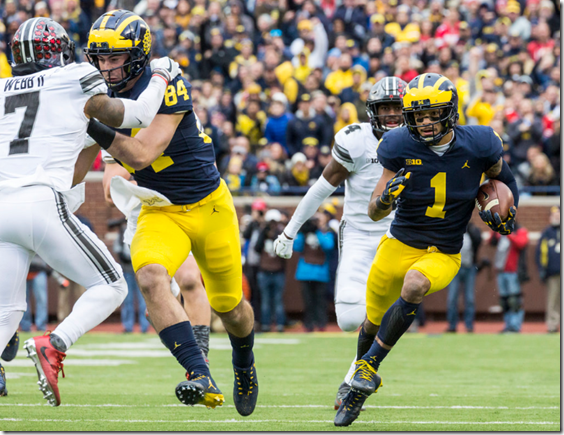
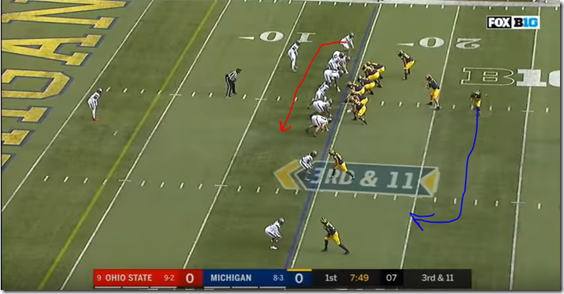
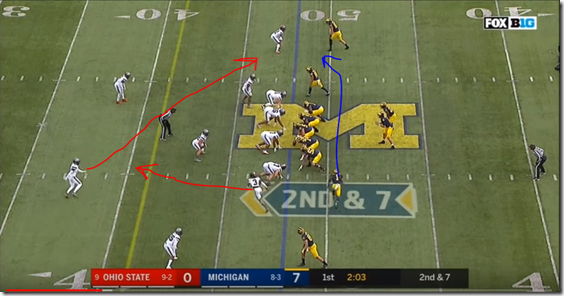

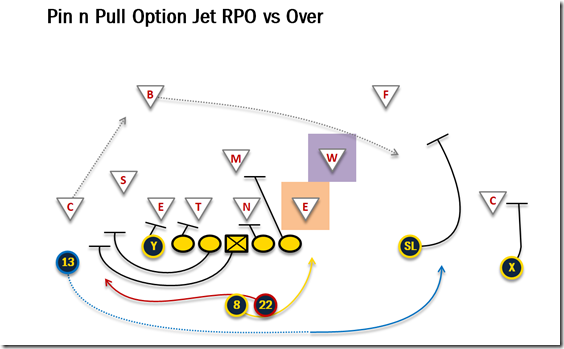
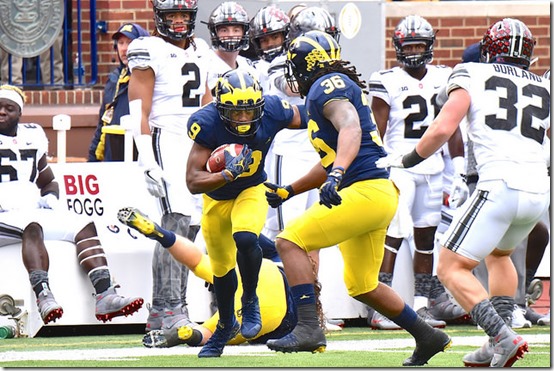
33